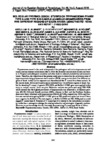MOLECULAR EPIDEMIOLOGICAL STUDIES ON TRYPANOSOMA EVANSI TYPE A AND TYPE B IN CAMELS (CAMELUS DROMEDARIES) FROM FIVE DIFFERENT REGIONS OF SAUDI ARABIA USING THE ITS1 RDNA AND ROTAT 1.2 VSG GENE
| dc.contributor.author | ALANAZI, A | |
| dc.contributor.author | Puschendorf, Robert | |
| dc.contributor.author | ALYOUSIF, M | |
| dc.contributor.author | AL-KHALIFA, M | |
| dc.contributor.author | ALHARBI, S | |
| dc.contributor.author | AL SHEHRI, Z | |
| dc.contributor.author | SAID, A | |
| dc.contributor.author | ALANAZI, I | |
| dc.contributor.author | AL-MOHAMMED, H | |
| dc.date.accessioned | 2022-11-07T13:22:32Z | |
| dc.date.available | 2022-11-07T13:22:32Z | |
| dc.date.issued | 2018-08-01 | |
| dc.identifier.issn | 1110-0583 | |
| dc.identifier.issn | 2090-2549 | |
| dc.identifier.uri | http://hdl.handle.net/10026.1/19896 | |
| dc.description.abstract |
Trypanosoma evansi is the most widespread of the pathogenic salivarian trypanosomes and cause a serious disease called (surra) that is affect the domestic animals such camels and horses in Tropical and subtropical countries and often leads to reduced productivity and economic losses. Therefore, the objectives of the present study were to determine the prevalence rates of trypanosomiasis using polymerase chain reaction (PCR) among camels from five different regions of Saudi Arabia and to sequence and characterized the T. evansi from these animals. In the current study, 832 camel blood samples collected from five different regions of Saudi Arabia for detecting T. evansi. A generic ITS1-PCR and RoTat 1.2 VSG gene were applied in this study to analyze camels’ blood samples. Molecular analysis was performed using ITS1-PCR which showed that the highest prevalence of trypanosomes was observed in Al-Qaseem province (50.1%) followed Riyadh province (49%), whereas in Hail and the Northern Borders, there were fewer infections with trypanosomes (28.4% &17.6%), respectively. PCR amplification was carried out targeting RoTat 1.2 VSG gene on TS1-positive samples and some of them were negative for RoTat1.2. The test negative in RoTat 1.2 PCR but ITS1 PCR positive could suggest T. evansi type B. Presence of T. evansi type B is interest to the international community, as this has a message to redesign the existing molecular and serological diagnostic markers. However, to our knowledge this the first study demonstrating T. evansi type B out of Africa. Keywords: Trypanosoma evansi, Camels, ITS1 rDNA , RoTat 1.2, PCR, Saudi Arabia. | |
| dc.format.extent | 241-250 | |
| dc.language | en | |
| dc.language.iso | en | |
| dc.publisher | Egypts Presidential Specialized Council for Education and Scientific Research | |
| dc.rights | Attribution-NonCommercial-NoDerivatives 4.0 International | |
| dc.rights.uri | http://creativecommons.org/licenses/by-nc-nd/4.0/ | |
| dc.subject | Infectious Diseases | |
| dc.subject | Vector-Borne Diseases | |
| dc.subject | Infection | |
| dc.title | MOLECULAR EPIDEMIOLOGICAL STUDIES ON TRYPANOSOMA EVANSI TYPE A AND TYPE B IN CAMELS (CAMELUS DROMEDARIES) FROM FIVE DIFFERENT REGIONS OF SAUDI ARABIA USING THE ITS1 RDNA AND ROTAT 1.2 VSG GENE | |
| dc.type | journal-article | |
| plymouth.issue | 2 | |
| plymouth.volume | 48 | |
| plymouth.publication-status | Published | |
| plymouth.journal | Journal of the Egyptian Society of Parasitology | |
| dc.identifier.doi | 10.12816/0050431 | |
| plymouth.organisational-group | /Plymouth | |
| plymouth.organisational-group | /Plymouth/Faculty of Science and Engineering | |
| plymouth.organisational-group | /Plymouth/Faculty of Science and Engineering/School of Biological and Marine Sciences | |
| plymouth.organisational-group | /Plymouth/REF 2021 Researchers by UoA | |
| plymouth.organisational-group | /Plymouth/REF 2021 Researchers by UoA/UoA06 Agriculture, Veterinary and Food Science | |
| plymouth.organisational-group | /Plymouth/Users by role | |
| plymouth.organisational-group | /Plymouth/Users by role/Academics | |
| dcterms.dateAccepted | 2018-01-01 | |
| dc.rights.embargodate | 2022-11-9 | |
| dc.identifier.eissn | 2090-2549 | |
| dc.rights.embargoperiod | Not known | |
| rioxxterms.versionofrecord | 10.12816/0050431 | |
| rioxxterms.licenseref.uri | http://creativecommons.org/licenses/by-nc-nd/4.0/ | |
| rioxxterms.type | Journal Article/Review |



